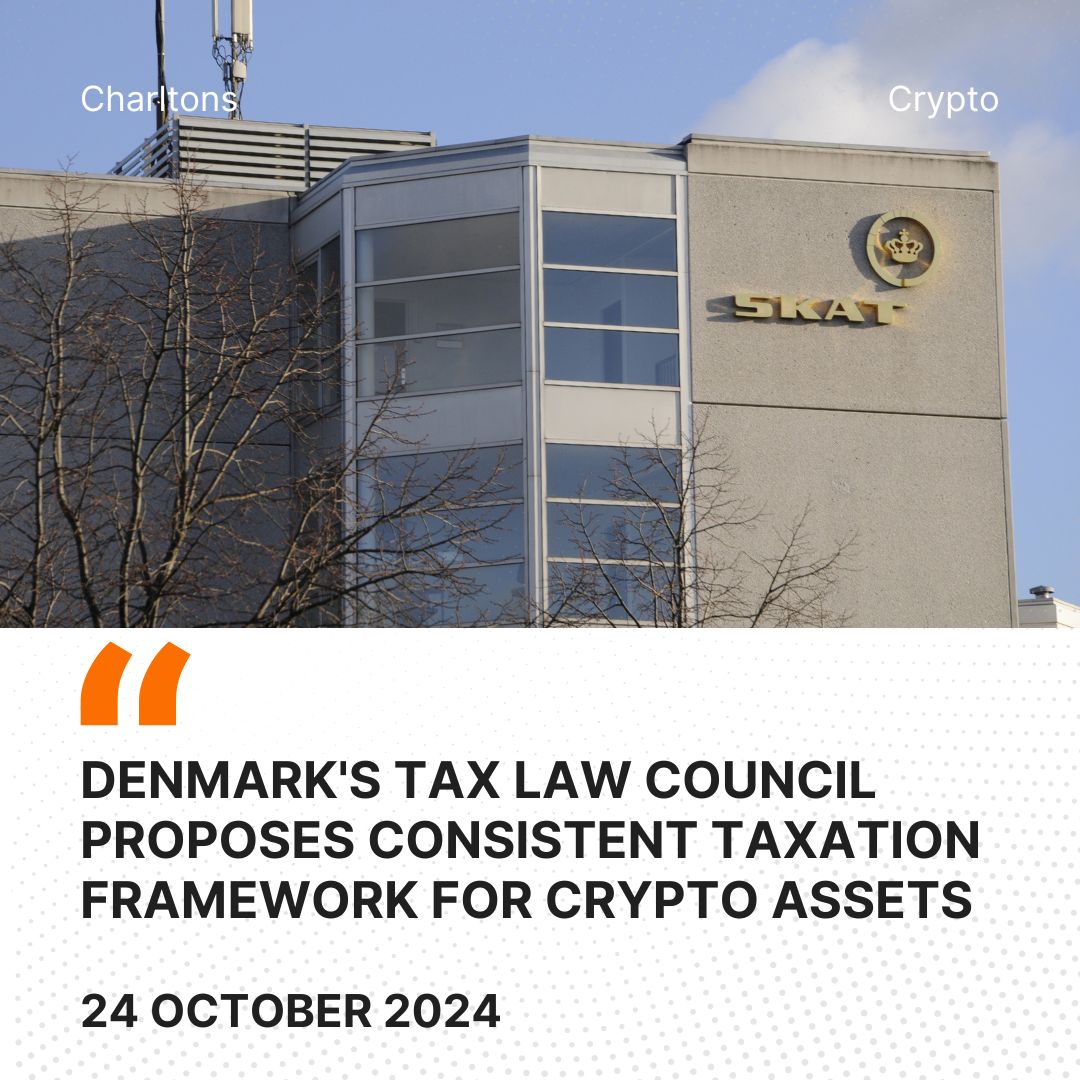
On 23 October 2024, the Danish Tax Law Council published a comprehensive report recommending changes to the taxation of crypto assets in Denmark. The report, titled “Finansielle Kryptoaktiver“, focuses on standardising the taxation framework to align with the growing prevalence of crypto investments among Danish citizens. With an estimated 300,000 Danes owning some form of crypto asset, the report addresses the need for more consistent and transparent tax regulations that reflect the unique nature of these digital assets. The recommendations outlined in the report are expected to lead to a legislative proposal in early 2025.
The report discusses the importance of addressing the current tax system’s limitations, particularly concerning the inconsistent application of tax laws to crypto assets. Presently, crypto investments fall under various tax regimes, depending on how they are classified. This fragmented approach has caused confusion among investors, many of whom struggle to calculate their tax liabilities accurately. The existing tax system also fails to account for the decentralized nature of crypto trading, which often occurs outside traditional financial institutions and regulated platforms. The Danish Council’s recommendation is to simplify this complex framework by unifying the tax treatment of all crypto assets, thus ensuring that investors are subject to the same rules regardless of the type of asset they hold.
Crypto assets, as described in the report, include a wide range of digital representations of value or rights that are stored and traded electronically using distributed ledger technology (DLT), such as blockchain. The report explains that crypto assets can take many forms, including cryptocurrencies like Bitcoin, which are decentralized and not backed by a central authority, and stablecoins, which aim to maintain a stable value by being pegged to a fiat currency or other assets. Utility tokens, which provide access to services within specific blockchain ecosystems, are also considered part of this growing market. These assets are typically traded on both centralized and decentralized platforms, adding further complexity to their tax treatment.
In an effort to provide clarity, the report outlines several definitions related to crypto assets and the technology that underpins them. Distributed ledger technology is described as a decentralized database used to verify and record transactions, while blockchain is a specific type of DLT where transactions are grouped into blocks and linked together in a chain. This technology ensures transparency and security, making it the foundation for most crypto assets. The report also discusses mechanisms such as Proof of Work (PoW) and Proof of Stake (PoS), which are used to validate transactions on the blockchain and reward participants with newly generated crypto assets.
Certain exemptions and special cases are also covered in the report. For example, the treatment of crypto assets received as gifts, or through blockchain forks, requires specific attention. A fork occurs when a blockchain splits into two, often resulting in holders receiving new tokens. The report recommends that such tokens should not be taxed at the point of receipt but only when they are sold or otherwise realized. Similarly, airdrops, free distributions of crypto assets, should be treated as taxable when the assets are sold, not when they are first acquired.
One of the issues addressed in the report is the taxation of gains and losses from crypto transactions. Under the current system, gains from crypto assets may be taxed under different regimes, depending on whether the assets are classified as speculative investments or financial contracts. This has led to situations where investors face tax liabilities on gains even if they have incurred losses overall. The Council proposes moving to a mark-to-market taxation model, where the value of crypto assets is assessed at the end of each tax year. Investors would be taxed on any appreciation in value, even if they have not sold the assets. Conversely, losses would be deductible, creating a more balanced tax framework.
The move to a mark-to-market model is expected to simplify tax reporting for frequent traders, as it removes the need to track every individual transaction. Instead, taxes would be based on the annual market value of the assets held. However, this model also introduces potential challenges, such as liquidity concerns. Investors may find themselves owing taxes on unrealized gains—gains that exist on paper but have not been converted into cash through the sale of the asset. The Council acknowledges this issue and recommends implementing measures to mitigate it, such as allowing losses to be carried forward to offset future gains.
In addition to addressing domestic tax concerns, the report places emphasis on international tax regulations. The Council highlights the need for Denmark to align its crypto tax laws with broader global efforts, particularly within the European Union. Two key international frameworks are discussed: the Markets in Crypto-assets Regulation (MiCA) and the DAC8 directive. MiCA aims to harmonize the legal treatment of crypto assets across EU member states to ensure that crypto exchanges and service providers follow consistent rules regarding investor protection and transaction reporting. DAC8 directive focuses on enhancing transparency by mandating the exchange of tax-related information between EU countries. This directive will make it easier for tax authorities to track cross-border crypto transactions and ensure accurate reporting.
The Council’s recommendations aim to create a more transparent and equitable tax system for crypto investors by adoption of the mark-to-market taxation model for all crypto assets, aligning them with the treatment of other financial contracts. The Council also suggests that exchanges and platforms that facilitate crypto transactions be required to report their customers’ activities to tax authorities. This would improve the ability of authorities to monitor crypto transactions and ensure that investors are complying with their tax obligations.
The report concludes with outlining the legislative changes that are expected to be introduced in early 2025. These changes will likely include mandatory reporting requirements for crypto exchanges, as well as the formal adoption of DAC8 and MiCA frameworks into Danish law. The Council proposes that the new tax rules should take effect no earlier than 1 January 2026, allowing time for investors and the financial industry to adapt to the changes. Once implemented, these rules will ensure that crypto trading is subject to a standardized and transparent tax regime, benefiting both investors and tax authorities.
(Source: https://skat.dk/en-us/individuals/shares-and-securities/tax-on-cryptocurrency-know-the-rules-and-avoid-a-tax-bill, https://skm.dk/ministeriet/om-skatteministeriet/publikationer-fra-skattelovraadet/rapport-om-finansielle-kryptoaktiver, https://skm.dk/media/5lwjf5qv/finansielle-kryptoaktiver.pdf)





